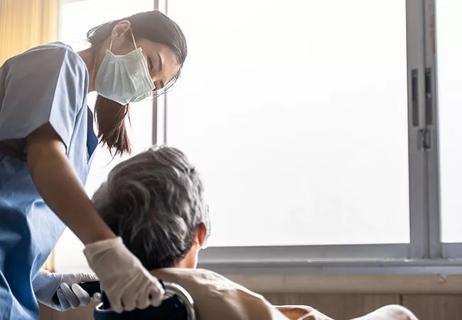Advertisement
Exercise should be part of every patient's plan of care

By Ronan Factora, MD, and Ami Hall, DO
Advertisement
Cleveland Clinic is a non-profit academic medical center. Advertising on our site helps support our mission. We do not endorse non-Cleveland Clinic products or services. Policy
“Movement is the penicillin of aging.”
This phrase encapsulates the need for older persons to maintain mobility and physical function. Too many individuals in the United States spend most hours of the day watching TV or on some sort of screen.
There is a growing body of literature highlighting the long-term down sides of sitting on the couch. We know that long periods of sitting have negative effects on a person’s blood sugar, cholesterol levels and blood pressure. Over time, lack of use of muscles and joints leads to increasing stiffness, reduced flexibility, loss of muscle mass and the accompanying reduction in muscle function. This leads to weakness and reduced speed and endurance. These consequences are all components of frailty syndrome, which is an independent indicator of risk of disability and death in an older person.
The vast majority of older individuals want to remain as independent as possible. But there is a challenge in educating them on the benefits of physical activity and an even bigger challenge in convincing them to exercise.
Once the word exercise is mentioned to patients, you will get different responses. There are seniors who have never exercised and see no reason to start no matter what you say. Others will start to listen when you tell them about the benefits of exercise to their heart and to their memory as well as their ability to remain independent throughout their lives.
Advertisement
The single best way to get people to begin incorporating physical activity into their lives is to talk to them about their life goals and to help match them up with the right type of exercise. One size does not fit all. People who are social may be more interested in doing a class at the senior center or YMCA. For those who need low impact exercise, chair yoga may be a good start because they won’t have to worry about falling.
Remaining mobile is an important part of staving off the normal aging process. Encouraging movement throughout the day should be a part of every plan of care for older persons.
Balance Exercises: Balance exercises are good for patients who are at risk for falls. For these patients evaluation by a physical therapist to identify balance problems, consider causes and develop a regimen of exercises tailored to the patient is important. Once learned, that person will be encouraged to do these exercises regularly to maintain balance and reduce fall risk.
Exercises shown to improve balance and reduce fall risks include tai chi and yoga. Participation in a 12- to 15-week tai chi course has been shown to reduce risk of falls over two years by as much as 30%. Tai chi video classes for home use will also confer some benefit. Data from clinical studies are also showing that of yoga impacts balance positively and can help reduce falls.
Resistance Training: Though reduction in muscle bulk and function does decline with normal aging, this process is accelerated with lack of muscle use. Resistance training using weights, machines, resistance bands, or even isometric exercises (such as pushups) can help to slow, stop, or reverse this process. Doing such exercises consistently for 12 weeks leads to measurable benefits on muscle mass and quality. Similar benefits can be obtained for the bones related to the muscles that are being exercised.
Advertisement
Cardiovascular Endurance: Many persons who are older complain of easy fatigue and low endurance. Cardiovascular exercise helps to improve both factors. There are many ways to engage in cardiovascular exercise. This can range from taking a brisk walk to an intense program of swimming, use of a stationary bike or running. If one feels short of breath while doing the exercise, it is considered cardiovascular exercise. Cardiovascular exercise benefit can be achieved in as little as 15 minutes each day. Cardiovascular exercise has a proven positive effective on memory/cognitive function, while it and reduces risk of disability and increases life expectancy.
Water exercise is great for people who have osteoarthritis. There are some facilities that will turn up the temperature of the pool during senior classes for better comfort. For patients with mobility issues some pools have ramps for ease of getting in and out of them.
For those who do not want to be committed to a class there are exercise machines, including the traditional treadmill, elliptical machines and stationary bikes.
Walking is another good option for many, especially when the weather is nice. Indoor malls are also good for walking with the benefits of benches for taking a break and even floors compared to sidewalks and trails, which lowers hazards for tripping.
If the senior is a competitive sports fan, there is pickle ball, table tennis, bocce ball, shuffleboard, and of course, golf.
For those who are technologically savvy, and during this time of COVID-19 when we are distancing from others, virtual exercise is a good option. This includes online activities and game systems, such as Just Dance® and Wii bowling or Wii golf.
For seniors who are wheelchair bound, there is a piece of exercise equipment called the floor peddler, which allows the person to sit in a chair and peddle like they would on a bike. It can also be put on a table and used to exercise the arms.
Providing patients a few choices is worthwhile, while also encouraging them to give these exercises a try for a couple of weeks before they decide what they want to make a routine. If a friend or a spouse can join them in the activities, there may be a higher chance of compliance.
Providing a plan of exercise, though challenging, provides a wide array of benefits to older persons, particularly if the exercises are individualized and targeted with specific goals in mind. Ensuring that the goals of the older person are clarified and met with this plan helps increase the probability that they will adhere to this plan.
There are some who already enjoy exercise. One 83-year-old patient ran the local 5-mile Johnny Cake Jog every year for 40+ years. She used to run marathons, but eventually her cardiologist advised her to stop. Her next question to him was, “Is a half marathon okay?”
Advertisement
But most patients are not like her. For other patients who are the naysayers, perhaps you simply need to keep reminding them that movement is the penicillin of aging.
Advertisement
Advertisement

Social prescribing turns leisure activities into good “medicine”

Study highlights importance of responsive, customized approach

Surrogate decision-making appears to increase risk of serious complications

Geriatric Emergency Needs Assessment

Cleveland Clinic joins Yale in new study

Unique model of care helps optimize medications in high-risk cohort

1-Minute Consult: Updated recommendation reflects reduced incidence of disease

Addressing cognition issues associated with cardiovascular disease